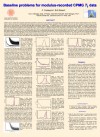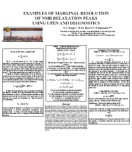|
|
||
|
POSTERS |
||
|
Examples of marginal resolution of NMR relaxation peaks using UPEN and diagnostic |
||
|
|
||
|
Baseline problems for modulus-recorded CPMG T2 data
|
||
|
CPMG T2 data
are usually taken using phase-cycled data accumulation to cancel any
non-zero baseline of instrumental origin.
In many cases this works well, even for high S/N (signal-to-noise
ratio) data. However, various
instrument or instrument-adjustment problems can prevent accurate
zeroing of baseline, especially for NMR instruments, such as the
“one-sided” instruments for measurements on large objects such as
statues, paintings, or buildings, employing highly inhomogeneous
magnetic fields. For high-S/N
phase-recorded echo data an accurately zeroed baseline is valuable in
computation of distributions of relaxation times, while an erroneous
assumption of zero baseline can give strikingly erroneous distributions,
sometimes including spurious sharp spikes.
If S∞ (baseline,
signal at infinite time) is not accurately known a priori for
phase-recorded data, then S∞ can
be included as a regression parameter in the computation to avoid
spurious results. However, it is
more difficult to deal with baseline errors for modulus (absolute-value,
or amplitude) data, where, with zero instrumental baseline, we have the
mean echo amplitude at long time S∞΄
= (π/2)˝ N,
where N is the single-channel noise.
Many modulus data sets have S∞ ≈
S∞΄,
but we have encountered data sets not compatible with this assumption.
For some of these cases we have used the value of N taken
from the S/N>>1 portion of the decay data to estimate S∞΄,
then using this to “correct” the set of modulus data to a set that has
zero mean at long time if the instrumental baseline is zero.
Then, S∞ can
be used as a regression parameter in an inversion computation,
subtracting different trial baseline amounts SB from
the data set until 0 < S∞ << N
for the modulus-corrected data set.
Even when there is not a clear baseline discrepancy, a small
amount added to or subtracted from the signal can give a consistent
modulus-corrected signal, with 0<S∞<<N
upon inversion. We have done this
using the inversion program UPEN.
Examples of modulus-recorded data are shown where the assumption of zero
baseline gives untenable results.
|
||
|
|
||
|
|
||
|
The multiexponential inversion program UPEN by the authors employs negative feedback to a regularization penalty to implement variable smoothing when both sharp and broad features appear on a single distribution of relaxation times. This allows a good fit to relaxation data that correspond to a sum of decaying exponentials plus random noise, but it usually does not give a good fit to data that are distorted by systematic errors from instrument problems, which can cause erroneous "resolution" or erroneous nonresolution of peaks. UPEN provides a series of diagnostic parameters to help identify such data problems that can lead to interpretation errors, and, in particular, to warn when a close call on the resolution or non-resolution of nearby peaks might be questionable. Examples are given from a series of T2 data sets from desiccated bone samples, with examples where the presence of two peaks is required by good data, examples where the presence of two peaks is negated by good data, and examples where the resolution or non-resolution of peaks cannot be trusted because of instrumental distortions revealed by UPEN diagnostic parameters. It is suggested that processing relaxation data with UPEN in nearly real time could permit retaking data while a sample is still available if the diagnostic parameters show instrumental problems. |
||
|
|
||


